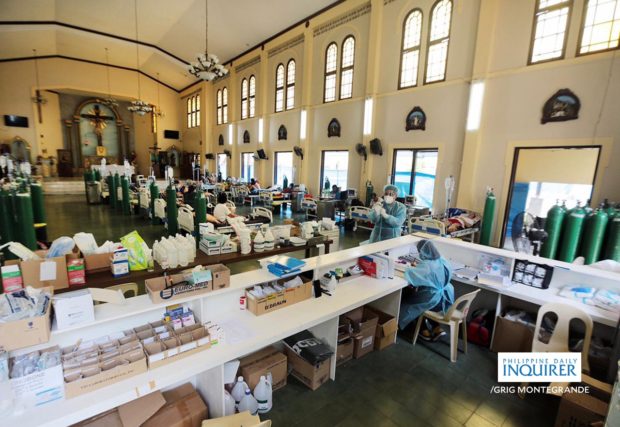
Health workers attend to patients at the chapel of Quezon City General Hospital and Medical Center (QCGHMC) on Thursday, Aug. 19, 2021, as it converted the chapel into an intensive care unit (ICU) ward as a response to the increasing number of severe COVID-19 cases. (File photo by GRIG C. MONTEGRANDE / Philippine Daily Inquirer)
MANILA, Philippines — The World Health Organization (WHO) on Wednesday said the Philippines ranked third on the list of 28 countries in the Western Pacific with the most COVID-19 infections and urged the government to start its “last-mile” vaccination of its priority populations, particularly seniors and persons with comorbidities.
It said that data as of Aug. 25 showed that the countries with the highest number of new cases were Malaysia, Japan, the Philippines, and Vietnam.
“Delta variant is here in the Philippines and like in other countries in the region, it is a very important moment for the Philippines,” said Dr. Takeshi Kasai, director of the WHO-Western Pacific Region, which is headquartered in Manila.
Kasai said the Philippines was facing a surge in cases not only in the capital but also in multiple provinces, as he took note of overwhelmed hospitals and “really exhausted” healthcare workers.
He said the Delta variant, by far the most transmissible of the SARS-CoV-2 variants, was partly driving the surges in the Western Pacific and now contributed more than 10 percent of new cases and 8 percent of deaths globally during the first three weeks of August.
“The Delta variant is now a real threat, which is testing the capacity of even the strongest public health system in our region,” he said.
The WHO noted the clusters of cases that led to bigger outbreaks especially in closed spaces, crowded places and close contact settings.
High infection rate
The Department of Health (DOH) on Wednesday said it recorded 13,573 new COVID-19 cases, bringing the total number of cases in the country to 1,883,088.
In its daily case bulletin, the DOH said cases were “relatively low” due to fewer laboratory output on Monday.
The positivity rate remained high at 25.5 percent, which meant one in four of the 46,193 individuals tested on Monday turned out to be positive for COVID-19. The WHO earlier said that the positivity rate should be below 5 percent to indicate controlled transmission of the virus.
Independent pandemic monitor Octa Research on Wednesday added that while the reproduction rate of COVID-19 in the National Capital Region (NCR) has gone down to 1.53, the region was still at critical risk since cases continued to climb.
In its latest NCR monitoring report, Octa said the reproduction number of the virus has gone down in the week covering Aug. 18-24. The week before, Octa said the figure was 1.78.
The reproduction rate measures how fast the virus spreads. A reproduction number of 1 or higher indicates a sustained transmission of the virus. In the week before Metro Manila and nearby provinces were placed under lockdown or enhanced community quarantine (ECQ) last year, the reproduction rate was 1.96.
According to Octa, the NCR averaged 4,019 new cases from Aug. 18 to 24, 13 percent higher than the previous week’s 3,556 new daily cases.
The report also said all local government units in the capital were still considered critical, with the exception of Manila, Quezon City, Caloocan and Marikina, which were classified as high risk.
Octa defined areas with an average daily attack rate (Adar) of 25 or higher to be critical, while an Adar of 10 or higher was considered high risk. Adar is the number of new daily cases per 100,000 population.
Nearing target
The WHO said the Philippines’ vaccine rollout was “doing quite well,” as it has fully vaccinated 95 percent of health-care workers and 46 percent of seniors, but prodded the government to scale up the inoculation particularly in local governments with slower vaccination rates.
In NCR, Metropolitan Manila Development Authority Chair Benhur Abalos said on the televised Laging Handa public briefing that 7.44 million or nearly 76 percent of the target 9.8 million eligible population have received at least a dose of COVID-19 vaccines.
He said the goal was to fully vaccinate 4.9 million or 50 percent of the eligible population by the end of the month, but he said this would depend on the intervals between the first and second doses, with some taking four weeks and others lasting as long as two to three months.
About 4.2 million have already completed their doses, he said. In the seniors’ group, he said 78 percent were already fully vaccinated.
More jabs coming
The country’s vaccine czar, Secretary Carlito Galvez Jr. said on Tuesday the Philippines might receive around 10 million vaccine doses next month as the country intensifies its mass inoculation drive to contain the spread of coronavirus,
In his report to President Duterte, Galvez said his team has negotiated with Pfizer Inc., which committed to deliver about 5 million doses in September. He said the team was also negotiating with Moderna for a supply of 3 to 4 million doses.
Galvez, the chief implementer of the National Task Force Against COVID-19, said that to ensure a steady supply of vaccines, the government has signed a purchase order with China’s Sinovac Biotech Inc. for an additional 10 million doses of its vaccine.
The government decided to buy more Sinovac after the 26 million doses of the Chinese vaccine had been depleted, Galvez said.
“What’s good here is that the prices are lower than the original prices. We’re seeing a more improved supply of Sinovac vaccines, it’s [becoming] steady,” the secretary said.